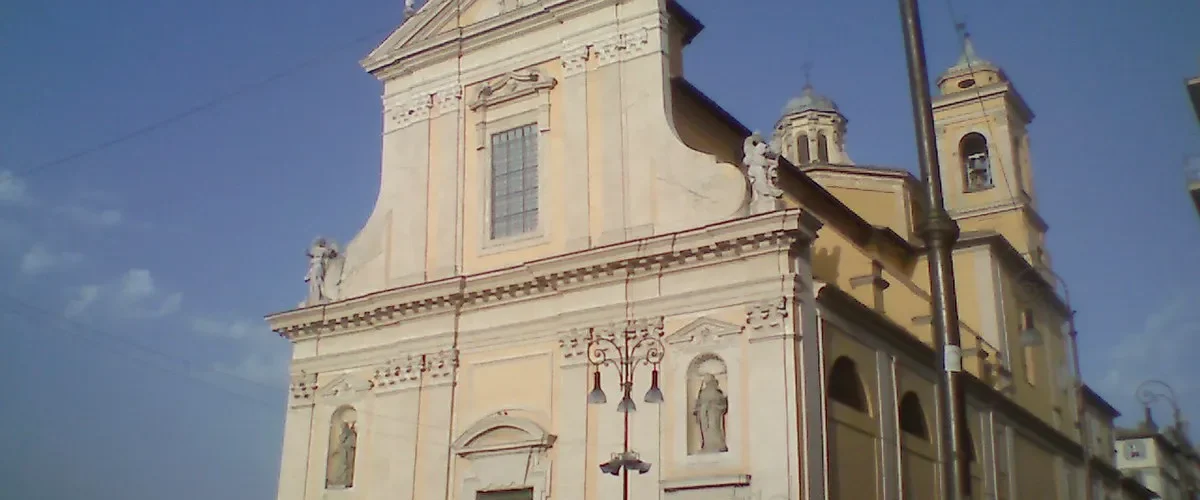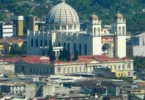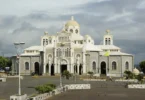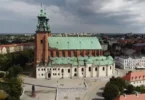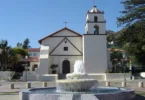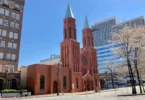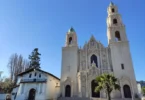Introduction
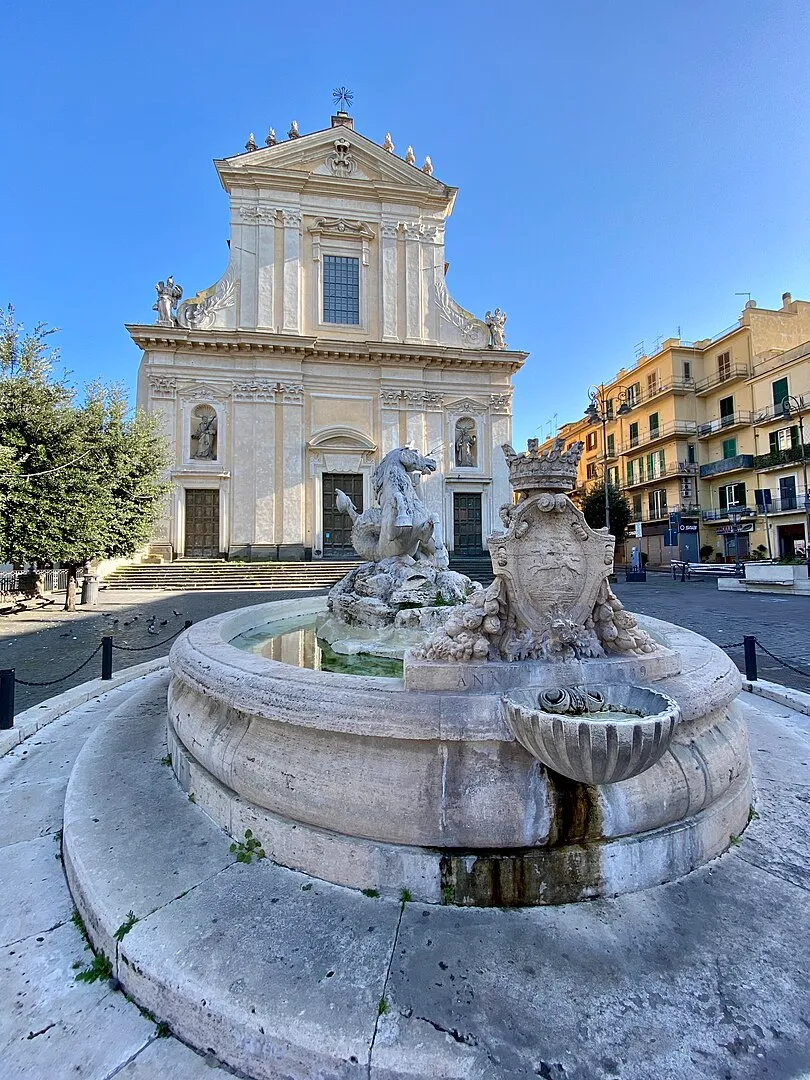
The Collegiate Basilica of St. Barnabas is the principal Catholic place of worship in the city of Marino, which is located within the Metropolitan City of Rome Capital and falls under the jurisdiction of the Suburbicarian Diocese of Albano. This historic basilica was constructed through the profound devotion of the Colonna family, who were influential patrons of the church. Not only is it one of the largest churches in the Diocese of Albano, but it also holds significant religious and cultural importance within the region.
The basilica has long been a central hub for religious life, particularly as the seat of the venerable Archconfraternity of the Gonfalone of Marino, which was founded around 1271 by Bonaventure of Bagnoregio. This confraternity played a prominent role in the spiritual life of the area for centuries. Additionally, the chapter of St. Barnabas, which oversees the basilica, was historically one of the most prominent chapters in the Diocese of Albano, sharing this distinction with the collegiate chapter of the Church of Santa Maria Assunta in Ariccia. This status was formally recognized in the diocesan synods of 1668 and 1687, highlighting the basilica’s crucial role in the ecclesiastical hierarchy and governance of the diocese.
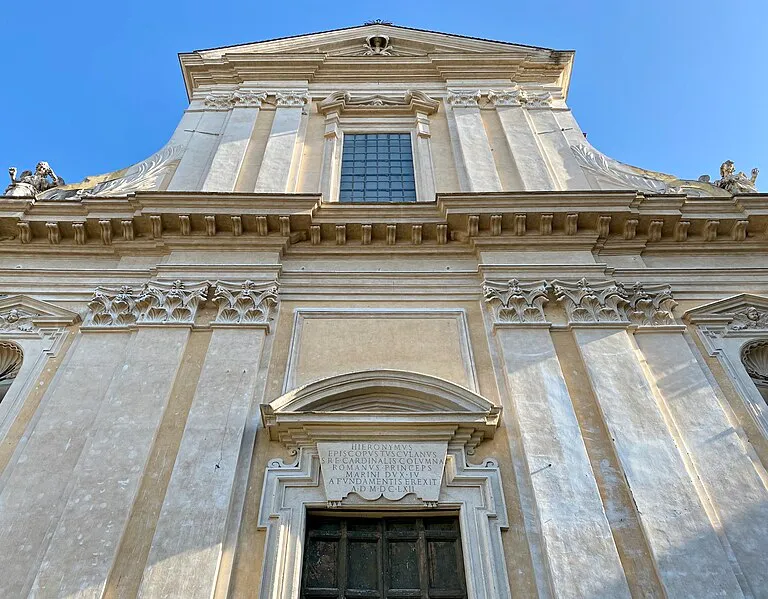
The Legend of St. Barnabas
Originally, the patron saint of Marino was St. Lucy, whose feast day is still celebrated annually on December 13. The town had a church dedicated to St. Lucy, situated in the lower-medieval part of the town, likely built in the 12th century on a Roman cistern and later reconstructed in the early 13th century by Jacoba of Settesoli. Part of this church, which is the only example of Gothic architecture in the Roman Castles, now houses the Umberto Mastroianni Civic Museum.
St. Barnabas became the patron saint of Marino after a series of natural calamities devastated the Marinese countryside. On June 11, 1615, a violent hailstorm ravaged the crops of Marino’s people, and two more hailstorms occurred on the same day in the following years, 1616 and 1617. In response to this recurring devastation, the community organized a plenary assembly on February 2, 1618, and resolved to petition Cardinal Francesco Sforza, the cardinal bishop of Albano, for permission to venerate St. Barnabas as their patron saint, since his feast day also fell on June 11. Cardinal Sforza granted the request on June 4, 1619, and from that point, St. Barnabas’ feast day was solemnly celebrated.
The Foundation of the Basilica
By the early 17th century, Marino had two parishes: the parish of St. Lucy and the parish of St. John the Baptist, the latter located in the Castelletto district. The two parishes had long been sources of conflict and division within the town. In an effort to resolve these issues, Duke Filippo I Colonna and his son, Cardinal Girolamo Colonna, decided to merge the two parishes and dedicate the new parish church to St. Barnabas. This decision was backed by ecclesiastical authorities, and the plan aimed to foster unity among the people of Marino.
On October 28, 1636, Monsignor Giovanni Battista Altieri, vicar general of the suburbicarian see of Albano, formally abolished the two parishes and consolidated them into the new parish of St. Barnabas. Despite initial challenges, including embezzlement of funds by the community’s treasurers, the foundation stone for the new parish church was laid on June 10, 1640, with the blessing of Cardinal Girolamo Colonna and the presence of Duke Filippo I Colonna.
Pope Urban VIII issued a bull on December 3, 1643, confirming the suppression of the two original parishes and elevating the new church to the status of a collegiate church, while also granting it the dignity of a nullius abbey. This established a chapter of twelve canons and six benefactors, led by an archpriest abbot parish priest, who would be responsible for the spiritual well-being of the parish.
17th to 19th Century Developments
By 1642, significant progress had been made on the basilica’s construction, including the completion of the church’s pillars and the vaulting of eight chapels. The building was approximately 58.75 meters in length, 24 meters in width at the transept, and had a dome height of 36 meters. The total construction cost amounted to about 30,000 scudi. Although construction was completed by 1655, the consecration of the church was delayed due to the devastating plague that struck the region in 1656, significantly reducing Marino’s population. The parish had to be repopulated with new settlers from Abruzzo. The first sung mass in the new Collegiate Church was celebrated on October 22, 1662, by Monsignor Carlo Tarugi, vicar general of the suburbicarian see of Albano. The church was officially consecrated on May 14, 1713, by Archbishop Antonio Sanfelice of Naples. In 1662, the image of Our Lady of the Rosary was moved from the old church of St. Lucy to the new basilica, solidifying the church’s growing importance within the town.
18th Century
Following the upheaval of the Roman Republic (1798-1799), Marino actively participated in the events of the French occupation. In 1799, Neapolitan troops camped in the Roman Castles and held a solemn mass at the Collegiate Church of St. Barnabas in memory of their fallen comrades.
19th Century
In 1851, Pope Pius IX elevated the church to the status of a minor basilica, while confirming the town’s affiliation with the suburbicarian see of Albano, a connection which had already been confirmed by Pope Gregory XVI in 1835 when Marino was granted city status. During the late 19th century, anti-clerical sentiments rose within the town, particularly among the republican factions. In 1899, the abbot parish priest, in opposition to the new Italian republic, forbade the entry of the Italian flag into the basilica during a mass for those who died in the Battle of Adwa.
The 20th Century
Early 20th Century and World War I
In 1902, an earthquake caused significant damage to the basilica, leading to restoration efforts in 1909, including reinforcement of the church’s pillars and arches. In the early 1900s, the parish was under the leadership of Abbot Attilio Pandozzi, who was removed due to his openly anti-clerical stance. He was succeeded by Fr. Guglielmo Grassi, who remained in charge of the parish until his death in 1954. During Grassi’s tenure, several notable initiatives were undertaken, including the founding of the Little Disciples of Jesus, a kindergarten for children during World War I, and a theater dedicated to Vittoria Colonna. Grassi’s collaboration with the Servant of God Zaccaria Negroni also led to the growth of the parish oratory. In 1911, a sacrilegious theft of the revered image of Our Lady of the People occurred, followed by another in 1914. Despite these setbacks, the parish community remained resilient.
World War II
During World War II, on February 2, 1944, the basilica was spared from bombing during an air raid by American forces. Many civilians sought refuge in the church’s basement and the nearby Vittoria Colonna hall-theater. However, on May 31, 1944, the basilica was struck during a series of Anglo-American air raids, resulting in significant damage to the roof and interior paintings. Restoration efforts began promptly, and the icon of Our Lady of the People, along with other damaged artwork, was restored. The basilica also became a symbol of the town’s resilience, with memorials dedicated to those who perished during the war.
Post-War Developments
After World War II, the parish continued to thrive under the leadership of Fr. Giovanni Eleuterio Lovrovich, who succeeded Fr. Grassi in 1954. Under his guidance, the parish expanded, and the Monsignor Guglielmo Grassi auditorium was inaugurated. Lovrovich’s tenure also saw increased collaboration with local political leaders and a deepening of the parish’s social engagement. In 1962, Pope John XXIII made an unexpected visit to Marino and prayed briefly in the basilica, marking the last papal visit to the town.
Late 20th Century and Restoration Efforts
In the 1960s and 1970s, several renovations took place in the basilica, particularly in the side chapels and the crypt. Notable restorations included the statue of St. Lucy and improvements to the presbytery area to comply with the new liturgical norms of the Second Vatican Council. In the 1980s, the basilica was once again targeted by thieves, with several important religious artifacts stolen. Despite these setbacks, the church continued to serve as a focal point for the local community. By the 1990s, under the leadership of Fr. Aldo Anfuso, the basilica experienced a renewed focus on educational and cultural activities, including the restoration of the Vittoria Colonna hall-theater. Major restoration work on the basilica’s façade was also undertaken during this time.
The 2000s
In 2008, Monsignor Aldo Anfuso completed his pastoral work in Marino and was succeeded by Monsignor Pietro Massari, who continued the parish’s work in the community. The same year, a delegation from Sierra Leone visited the basilica, marking a significant moment in the parish’s international engagement.
Architecture of Basilica of St. Barnabas, Marino, Italy
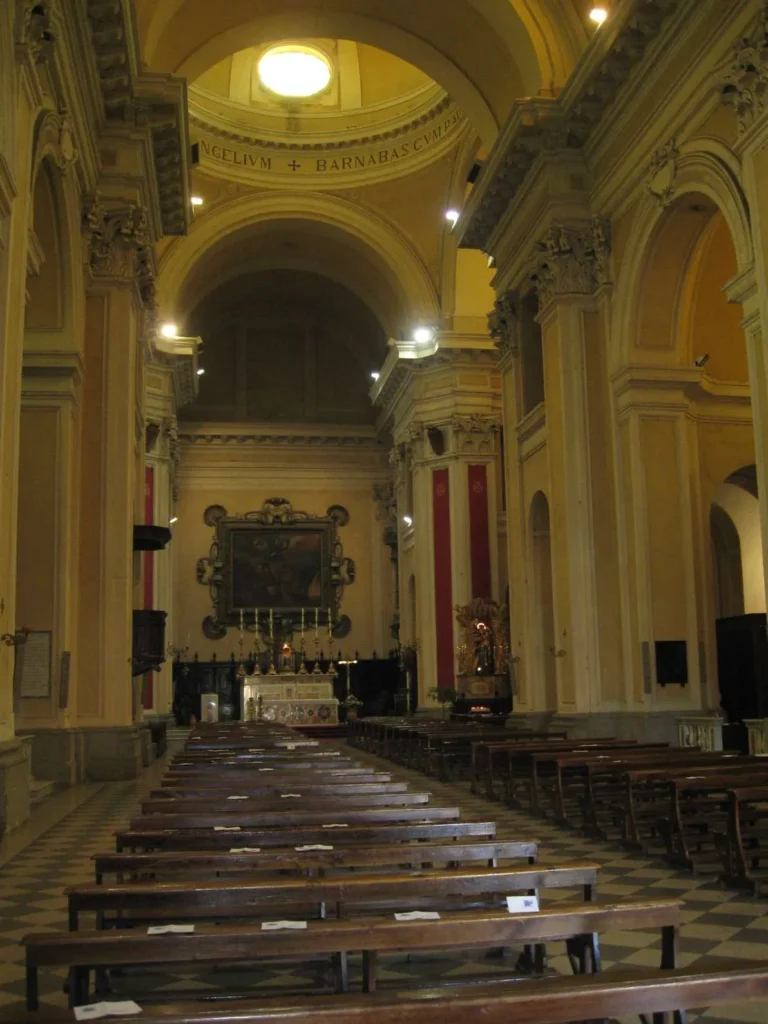
Architect: Antonio Del Grande
Architectural Styles: Baroque architecture
The Basilica of San Barnaba: A Detailed Overview
Description
The village church of San Barnaba, reminiscent of the larger churches found in the Lombardy countryside, is imbued with a profound sense of beauty. Inside, the atmosphere is welcoming rather than awe-inspiring. At the high altar, the statue of the Virgin Mary, familiar and cherished, is haloed and gilded, poised to be carried among the congregation. The inscription “Progreditur quasi aurora consurgens” reflects the gentle, uplifting spirit of the church. In the Evangel horn, a showcase displays the shield of Lepanto, a relic from the historic battle, hinting at the involvement of Marcantonio Colonna and his Marinese compatriots.
Architectural Design
The basilica’s interior, designed by Antonio Del Grande, is spacious and unadorned yet well-proportioned. Del Grande was a trusted architect of the Colonna family, known for his work on the parish church of Santa Maria Assunta in Rocca di Papa and the Palazzo Colonna in Rome. The construction was overseen by builders Giovanni Maria Longhi, Vincenzo della Greca, and Paolo Andreotti, with Fabrizio Vannutelli supervising the work.
Exterior
The facade of the basilica, completed between 1652 and 1653, features a horizontal division into lower and upper sections and is tripartite with six giant Corinthian lesenes. Three doors punctuate the facade, with inscriptions honoring Cardinal Girolamo Colonna, who commissioned the church. The central entrance portal bears a plaque commemorating the construction of the basilica in 1662. Above the side doors are niches housing statues of Saint Barnabas and Saint Lucy, both co-patron saints of the city. The tympanum displays the coat of arms of Cardinal Girolamo Colonna, while the pediment is adorned with an iron cross and six peperino torches.
Interior
The basilica’s interior follows a basilica plan with three naves, measuring 58.75 meters in length and 24 meters in width at the transept, with a dome lantern rising 36 meters high. The nave is covered by a lunetted barrel vault, while the side naves feature barrel vaults oriented orthogonally to the main nave. Natural light filters through six lunettes and the dome’s lantern windows. The total expenditure for the construction ranged from 12,000 to 24,000 pontifical scudi.
The Counterfacade
Above the main entrance, a commemorative plaque honors Cardinal Girolamo Colonna, detailing his contributions to the basilica. Additional plaques commemorate restorations and significant events, including a 1909 restoration following earthquake damage and a 1962 visit from Pope John XXIII.
The Right Aisle of the Basilica
First Bay
The first bay features a wooden statue of St. Anthony of Padua and a canvas depicting the “Vision of St. Anthony of Padua.” A bronze cross from the holy door of the basilica of St. John Lateran is also displayed here, along with a description of its significance.
Second Bay
This bay houses the altar of St. Anthony the Great or St. Joseph, maintained by the Confraternity of Charity. The marble statue of St. Anthony is by sculptor Ercole Ferrata, while the painting of St. Joseph with the Child Jesus was created by Anna Maria Meucci in 1871.
Third Bay
The altar of Our Lady of the People is located in this bay, featuring a miraculous icon attributed to St. Luke. The icon was brought to Marino in the 15th century and has been venerated for its intercessory power during times of crisis. Surrounding the altar are 18th-century stucco panels depicting biblical scenes, and a shrine houses an Ottoman shield from the Battle of Lepanto.
The Left Aisle of the Basilica
First Bay
The first bay of the left aisle, mirroring the layout of the right aisle, does not house an altar but instead features an anonymous gilded wooden statue of St. Lucy. St. Lucy is venerated as the co-patron saint of Marino, and the statue plays a prominent role during the feast day of St. Lucy, celebrated on December 13. Behind the statue is a large canvas painting depicting the Assumption of the Virgin Mary, created by Pier Leone Ghezzi. This artwork, which was previously located in the Coroncina Oratory below the church, was transferred here after the oratory was repurposed in the 1920s into an auditorium.
Second Bay
The second bay of the left aisle is occupied by the Altar of the Crucifix (also known as the Altar of Our Lady of Sorrows). This altar is named after a large wooden crucifix attributed to a 14th-century Umbrian school of art. Beneath the crucifix is a small depiction of “Our Lady of Sorrows,” painted by Carlo Maratta. The walls of this chapel are adorned with several marble plaques, which commemorate the names of those who lost their lives in the Anglo-American air raids of February 2 and 17, 1944, as well as subsequent air raids that devastated the area.
Third Bay
In the third bay of the left aisle is the Altar of the Sacred Heart, which was restored in 1952 to mark the 50th anniversary of the priestly ordination of Giovanni Battista Trovalusci. At that time, Monsignor Trovalusci was the vicar general of the suburbicarian diocese of Albano. The large altar painting, created by Giuseppe Ciotti in 1966, depicts suffering humanity turning to the Sacred Heart of Jesus under the guidance of Monsignor Trovalusci. Located at the second pillar of this bay is a marble tombstone commemorating Domenico Terribili, a sub-officer of the Papal Gendarmerie. He was awarded the Order of St. Sylvester and passed away on January 10, 1859.
The Transept of the Basilica
Right Transept
The right transept of the basilica is home to the altar dedicated to the Blessed Sacrament, also known as the altar of Our Lady of Mount Carmel. This altar was crafted by Giovanni Battista Mochi, who used a combination of ancient colored marbles, including antique yellow marble, black marble, and serpentine marble. The altarpiece is a large, anonymous painting that features Our Lady of Mount Carmel, the Child Jesus, and Saints Teresa of Avila and John of the Cross. The tabernacle located here is a modern creation by the sculptor Luigi Gozzi.
Left Transept
On the left side of the basilica, the altar of St. Bartholomew stands as a distinguished example of a privilegiatum altar, constructed by Giulio Galantini of Marino and his family in the second half of the 17th century. This altar, built using colored ancient marbles, is notable for its inlaid altar frontal. The altarpiece above the altar depicts the “Martyrdom of St. Bartholomew,” painted by Giacinto Campana. This work is a contemporary replica of the original painting by Giovanni Francesco Barbieri, created around 1635/1636 and now housed in the church of San Martino in Siena. The painting is thought to have been commissioned by Cardinal Girolamo Colonna. A second copy of the painting, dated 1774, was created by the artist Annunziata Verchiani and is currently displayed in the Church of the Visitation in Viterbo.
The Dome
The dome is pavilion-shaped externally and rounded internally, with a lantern rising 31 meters high. The base of the dome features an inscription honoring St. Barnabas.
The Chancel and Winter Choir of the Basilica
The chancel of the basilica features a prominent painting depicting the Martyrdom of St. Barnabas, attributed to Bartolomeo Gennari or possibly Guercino. This artwork is framed with a Latin inscription Divo Barnabae (“To Saint Barnabas”). On either side of the tabernacle, two marble niches created by Carlo Spagna and Gabriele Renzi house significant monuments. The right niche contains a monument to Cardinal Girolamo Colonna, sculpted by Alessandro Algardi, showing the cardinal praying on a prie-dieu. Despite his wish to be buried in Marino, it is believed Cardinal Colonna rests at the Basilica of St. John Lateran in Rome. The tabernacle is a 17th-century masterpiece of peach-flower marble with a silver canopy supported by Corinthian columns. To the right of the altar is the baptismal font, designed by 17th-century Roman artists, crafted from black marble with wooden columns. In the winter choir chapel, noteworthy works include a St. Francis of Assisi attributed to either Girolamo Muziano or Giovan Battista Caracciolo, a Humanity of Christ by Cherubino Alberti after Michelangelo, and two ovals depicting St. Peter and St. Paul by Guido Reni. The chapel also houses a St. Roch, a copy of a painting originally intended for the chapel in the village of St. Roch, destroyed in 1944. Additionally, the chapel boasts ceiling frescoes of the Glory of the Holy Spirit and walnut choir stalls from 1747.
The Parish
The basilica of San Barnaba serves as the most significant parish in Marino, with a history of being led by a mitred abbot since 1731. It is one of the few basilicas in the diocese, alongside the cathedral basilica of San Pancrazio in Albano Laziale. The parish covers a diverse population and includes several localities and churches within its territory. In summary, the Basilica of San Barnaba is a remarkable architectural and historical site, rich in art and religious significance, serving as a central place of worship and community in Marino.
Feast Day
Feast Day: 11 June.
The feast day of the Basilica of St. Barnabas in Marino, Italy, is celebrated on June 11th. This is the feast of St. Barnabas, the apostle, who is the patron saint of the basilica. The day honors St. Barnabas’s life and contributions to the early Christian Church.
Church Mass Timing
Monday : 7:30 AM , 6:00 PM
Tuesday : 7:30 AM , 6:00 PM
Wednesday : 7:30 AM , 6:00 PM
Thursday : 7:30 AM , 6:00 PM
Friday : 7:30 AM , 6:00 PM
Saturday : 7:30 AM , 6:00 PM
Sunday : 8:00 AM , 11:00 PM , 6:00 PM
Church Opening Time:
Monday : 07:30 am–12:00 pm, 3:30 pm –7:00 pm
Tuesday : 07:30 am–12:00 pm, 3:30 pm –7:00 pm
Wednesday : 07:30 am–12:00 pm, 3:30 pm –7:00 pm
Thursday : 07:30 am–12:00 pm, 3:30 pm –7:00 pm
Friday : 07:30 am–12:00 pm, 3:30 pm –7:00 pm
Saturday : 07:30 am–12:00 pm, 3:30 pm –7:00 pm
Sunday : 07:30 am–12:00 pm, 3:30 pm –7:00 pm
Contact Info
Address :
Corso Trieste, 7, 00047 Marino RM, Italy.
Phone : +39069387049
Accommodations
Connectivities
Airway
Basilica of St. Barnabas, Marino, Italy, to Campo Di Volo G.A.O., Via Laurentina distance between 34 min (23.8 km) via Via di Porta Medaglia.
Railway
Basilica of St. Barnabas, Marino, Italy, to Roma Trastevere Railway station distance between 47 min (30.1 km) via A90/E80.

